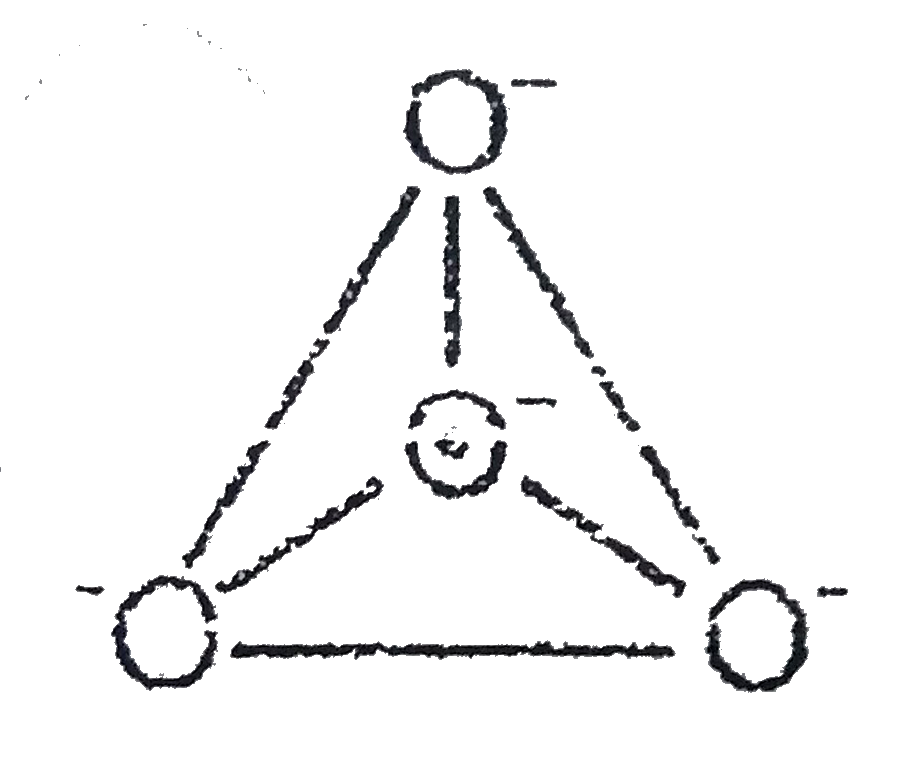(Sio3)n2n- can represent- (a) Cyclic silicates, (b) Chain silicates, (c) Pyrosilicatees
(a) and (b)
(a) and (c)
Only (a)
Only (b)
To solve the question regarding the representation of (SiO3)n2n- in terms of silicate types, we will analyze the characteristics of cyclic silicates, chain silicates, and pyrosilicates step by step.
Step 1: Understand the General Formula
The given formula is (SiO3)n2n-. This indicates that for every n units of SiO3, there is a charge of -2n. This formula suggests a specific arrangement of silicon and oxygen atoms.
Hint: Look for patterns in how silicon and oxygen are arranged in different types of silicates.
Step 2: Analyze Cyclic Silicates
Cyclic silicates are characterized by the sharing of two oxygen atoms per tetrahedron, forming closed rings. The general formula for cyclic silicates can be expressed as (SiO3)n2n-. This matches our given formula.
Hint: Recall that cyclic silicates form closed structures, which is key to identifying their formula.
Step 3: Analyze Chain Silicates
Chain silicates involve the sharing of two oxygen atoms per tetrahedron, forming linear chains. The general formula for chain silicates is typically represented as (SiO3)n2n- or SiO3 whole n-2. This indicates that while they share some similarities with the given formula, they do not match it exactly.
Hint: Consider the structure of chain silicates and how they differ from cyclic structures.
Step 4: Analyze Pyrosilicates
Pyrosilicates are formed when two SiO4 tetrahedra share one corner, resulting in the anion Si2O7-6. The general formula for pyrosilicates does not align with (SiO3)n2n-, as it involves a different structural arrangement.
Hint: Focus on the bonding and structural differences between pyrosilicates and the other types.
Step 5: Conclusion
Based on the analysis:
- (SiO3)n2n- can represent cyclic silicates, as it matches their general formula.
- It does not accurately represent chain silicates or pyrosilicates.
Thus, the correct answer to the question is that (SiO3)n2n- can represent cyclic silicates.
Final Answer: (a) Cyclic silicates.
The given formula is (SiO3)n2n-. This indicates that for every n units of SiO3, there is a charge of -2n. This formula suggests a specific arrangement of silicon and oxygen atoms.
Cyclic silicates are characterized by the sharing of two oxygen atoms per tetrahedron, forming closed rings. The general formula for cyclic silicates can be expressed as (SiO3)n2n-. This matches our given formula.
Chain silicates involve the sharing of two oxygen atoms per tetrahedron, forming linear chains. The general formula for chain silicates is typically represented as (SiO3)n2n- or SiO3 whole n-2. This indicates that while they share some similarities with the given formula, they do not match it exactly.
Pyrosilicates are formed when two SiO4 tetrahedra share one corner, resulting in the anion Si2O7-6. The general formula for pyrosilicates does not align with (SiO3)n2n-, as it involves a different structural arrangement.
Based on the analysis:
- (SiO3)n2n- can represent cyclic silicates, as it matches their general formula.
- It does not accurately represent chain silicates or pyrosilicates.
Topper's Solved these Questions
Similar Questions
Chain silicates can be represented as
View SolutionC4H11N can represent :
View SolutionC3H9N cannot represent
View SolutionIn which of the following silicates, only two corners per tetrahedron are shared ?
I. Pyrosilicate
II. Cyclic silicate
III Double chain silicate
IV Single chain silicate
V 3D Silicate
View SolutionMatch
Column IColumn II(A)Sheet silicate(p)Contain Si-O-Si bond(B)Silicone(q)General formula(SiO3)−2nn(C)Cyclic silicates(r)Si2O−67(D)Pyro silicate(s)(Si2O5)−2nn
View SolutionMatch the materials listed in the column−I with type of silicates listed in column −II , and select the correct answer using the code given below the list :
Column−IColumn−II(a)Spondumene(p)Two dimensional sheet silicates(b)Throteveitite(q)Pyrosilicates(c)Kaolin(r)Chain silicates(d)Quartz(e)Three dimensional sheet silicates.
View Solutionthe overall charge present on the cyclic silicate anion [Si6O18]n− is:
View Solutionthe overall charge present on the cyclic silicate anion [Si6O18]n− is:
View SolutionSilicon is the second most abundant element (~27.2%) in the earth's after oxygen (45.5%) Carbon. Silicon, germanium, tin and lead constitute the group 14 of the periodic table. Chemistry of silicon is distinctly different from that of carbon.
For example, under standard conditions CO2 is a gas whereas SiO2 is a covalent solid.
Draw the structure of a cyclic silicate having structural formula of [Si6O18]n−.Also determine the value of n
[Hint : SiO4−4 can be shown as unit]
unit]
View SolutionDraw the structure of a cyclic silicate, (Si3O9)6− with proper labelling.
View Solution
